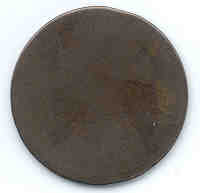Grade of the coin is what tells us about the quality of a coin. That is, how worn out a coin is or how good a condition is the coin in. Grading has nothing to do with the rarity or antiquity of a coin. Grading is essentially an art, which means that there is no standard or precise demarcation between the different grades, just a general guideline. Grading is done on an intuitive, judgmental basis, and grading done by two individuals may well differ. There is not even a standard accepted set of grades, but again some loosely defined grades with loose ends open for interpretation. I am putting up a list of grades, strating from the poorest, which in my opinion are the basic grades and are used in the terminology 90% of the time:
1)BASAL STATE: This type of coin is completely worn out and is barely recognizable to be a coin. No date, no features,no nothing can be seen. This is also rarely found and its value is the lowest.

2)POOR(PO): A little of the features are visible but again, very poor quality.

3)FAIR(F): With fair coins, you can see enough of the design and inscriptions to determine the coin's type - The coin above is an Edward VII florin. Depending upon the type of wear, the date may or may not be visible. The term "Fair" is sometimes also used to describe coins which are less worn than the coin above, but exhibit serious faults. Other examples of damaged coins include those that are bent, severely discoloured, rusty etc.

4) ABOUT GOOD/ALMOST GOOD(AG): Outlined design. Parts of date and legend worn smooth.This is a used up coin. You should be able to make out the date (possibly with some effort). Often, only parts of the last two digits will be visible.

5) GOOD(G): Outlined design. Parts of date and legend worn smooth. A good coin is heavily worn and shows little or no detail, but its design and legend are visible though faint in spots, and its date is legible.


6)VERY GOOD(VG): The design and legends of VG coins display little or none of the fuzziness of Good coins, yet the coins still fail to exhibit much detail. Take a look at the coin below - the king now enjoys the benefit of a full ear, but appears to suffer from extensive baldness.


7) FINE(F): Fine coins show some detail, and the main elements of their design appear clear and bold. Moderate to heavy even wear.

8)VERY FINE(VF): On Very Fine coins, all major features are sharp, but evidence of wear is apparent on the higher surfaces of the coin, and some fine detail will be worn or absent. The coins shown below, for example, has ample but incomplete hair detail, while the facial features of the lions within the shield will appear somewhat imprecise.


8) EXTREMELY FINE(EF/XF): Very light wear on only the highest points.Extremely Fine coins show evidence of handling on only their highest points. If you examine the above coin closely, you will find that some strands of hair appear flat in areas. EF coins that have suffered from little exposure to the elements and managed to retain most of their original mint lustre are often referred to as "Lustrous EF".

9)UNCIRCULATED(UNC): Uncirculated coins exhibit no wear at all, though small marks may be apparent as a result of contact with other coins at the mint and during transportation/packaging. These small marks are referred to as "bag marks" (BM). Coins which retain 100% of their original detail but show evidence of handling or minimal wear can be referred to as "AU" (about/almost uncirculated).


10) BRILLIANT UNCIRCULATED(BU): Uncirculated coins with full original mint lustre are referred to as "Brilliant Uncirculated". The coin shown in the picture is the golden £ 5, minted in 1988. A brilliant uncirculated coin should not show smudge marks even under a 30-point microscope, and is having proof-like characteristics. This one had a price tag of £525, and the bullion version released had a price of £325. So the buyers may have felt cheated as they bought this for more than double its cost in gold. The same coin released in 2008 has a price of euro 1390.

11)PROOF: This is the coin of the highest quality. It is minted under stringent quality norms and strict supervision. The metal for the coin is first carefully selected in which the selection % is barely 20%. Then it is struck at least twice with polished dies to produce an absolute mirror-like surface. You can easily see the reflection of the foreground in this 100 rupee coin.50% of this coin is silver. These proof coins also have an easily identifiable mint mark. This one had 'M' symbol on its reverse. Proof here is used as it is in waterproof and bulletproof, because this coin is proof of dust, smudge or bag marks and even the slightest wear and tear. Even its handling is done much more carefully as compared to an uncirculated coin and there is no chance of this coin getting wear and tear before reaching its intended recipient. I recieved this coin in a CD-mailer type air padded envelope.


No comments:
Post a Comment